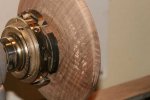Tom Baugues
Member
- Messages
- 2,794
- Location
- Lafayette, Indiana
Ok, so I'm trying to turn my first real bowl from some black walnut. I've only made pens and other small projects up to this point. I have it pretty much to the final shape that I want. I've started sanding it and this is where I have questions. I have been sanding on this for about 30-45 minutes. I can't seem to get the end grain to smooth out. I started with 400 grit but I now have gone UP to 80 grit holding sandpaper by hand. I'm sure some of or maybe most of it is my lack of skill turning and maybe I needed to spend more time with a tool but for my limited experience I thought I was ready to start sanding. Anyway...my question is what grit do you all start out with? I will spend some more time on the bottom of the bowl with a tool when I turn it over as it is still rough near the tenon but help me get the inside smooth for now. I'm sure the real answer here is to extract cash from my wallet and purchase some kind of sanding tool  so if you think that will help...then what do you suggest?
so if you think that will help...then what do you suggest?
Tom
 so if you think that will help...then what do you suggest?
so if you think that will help...then what do you suggest?Tom
Attachments
Last edited:





